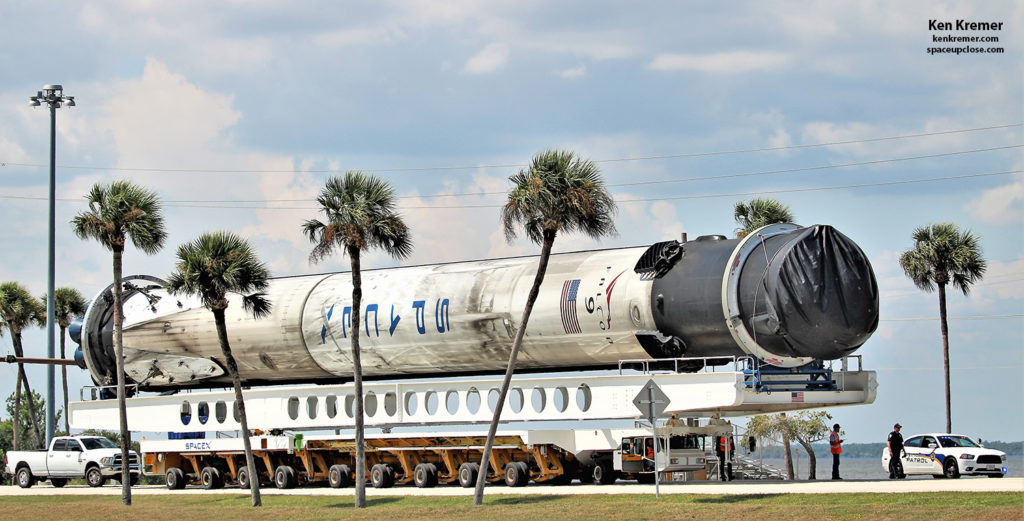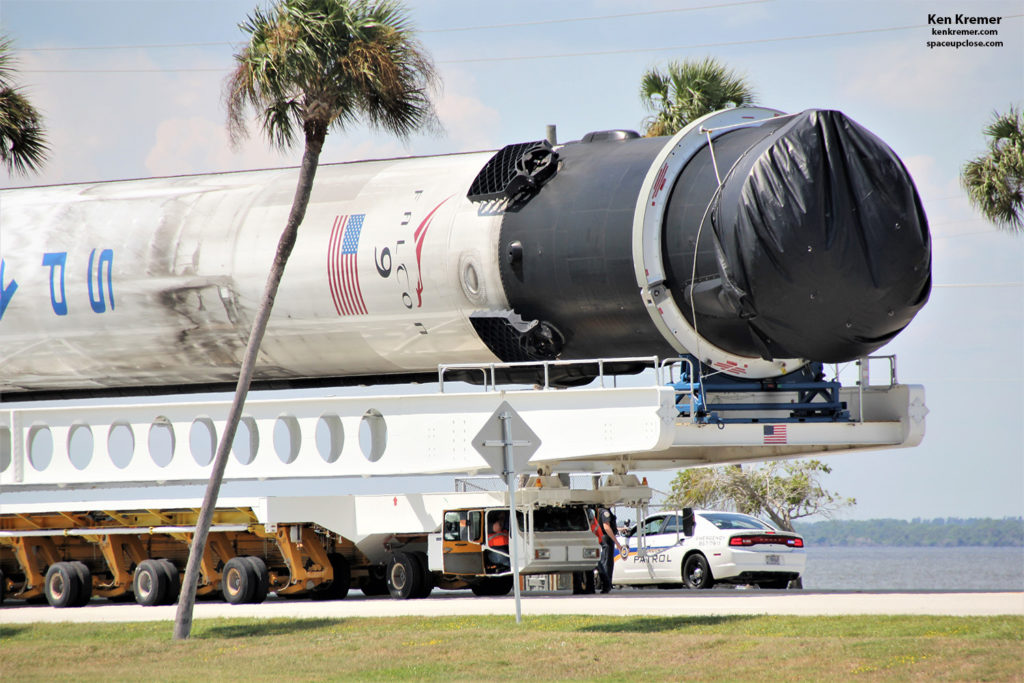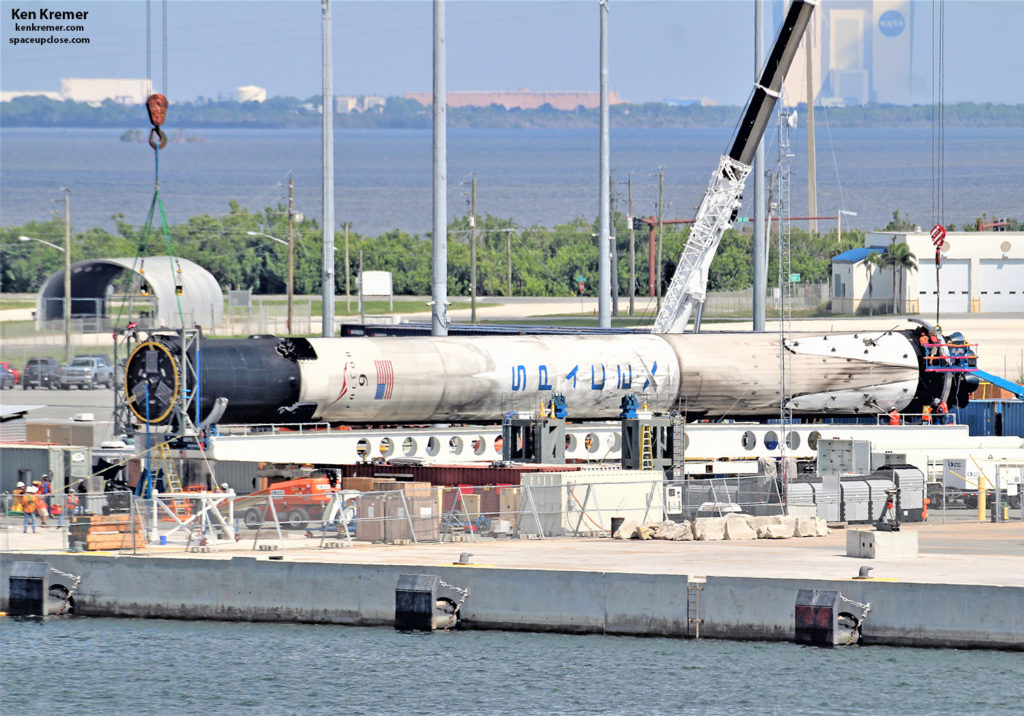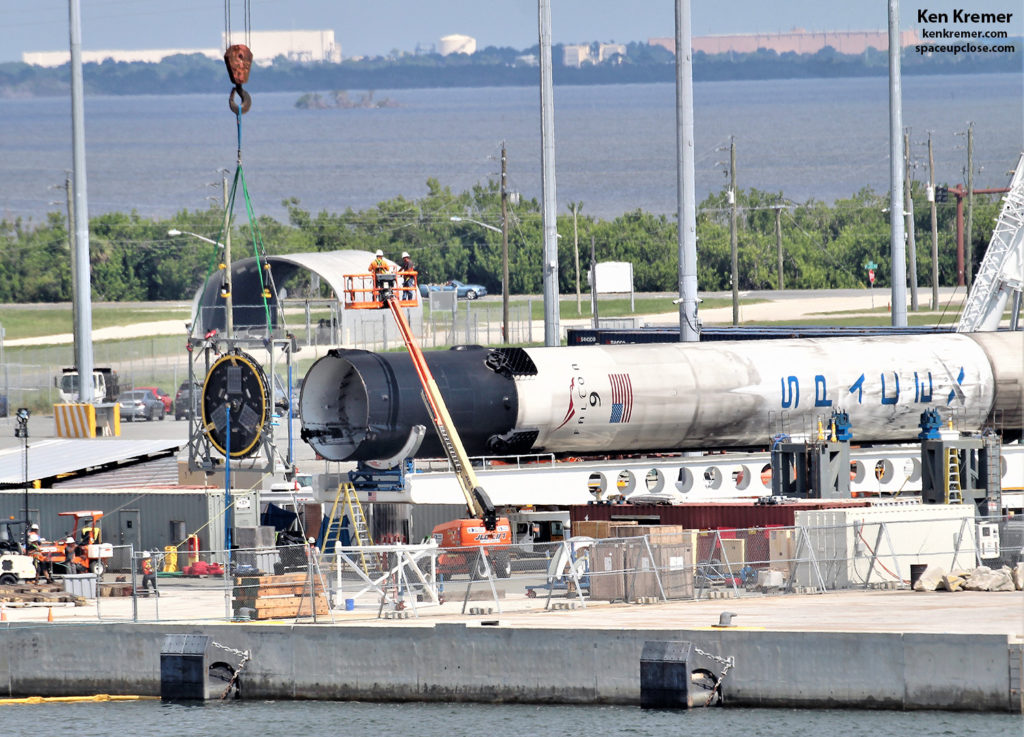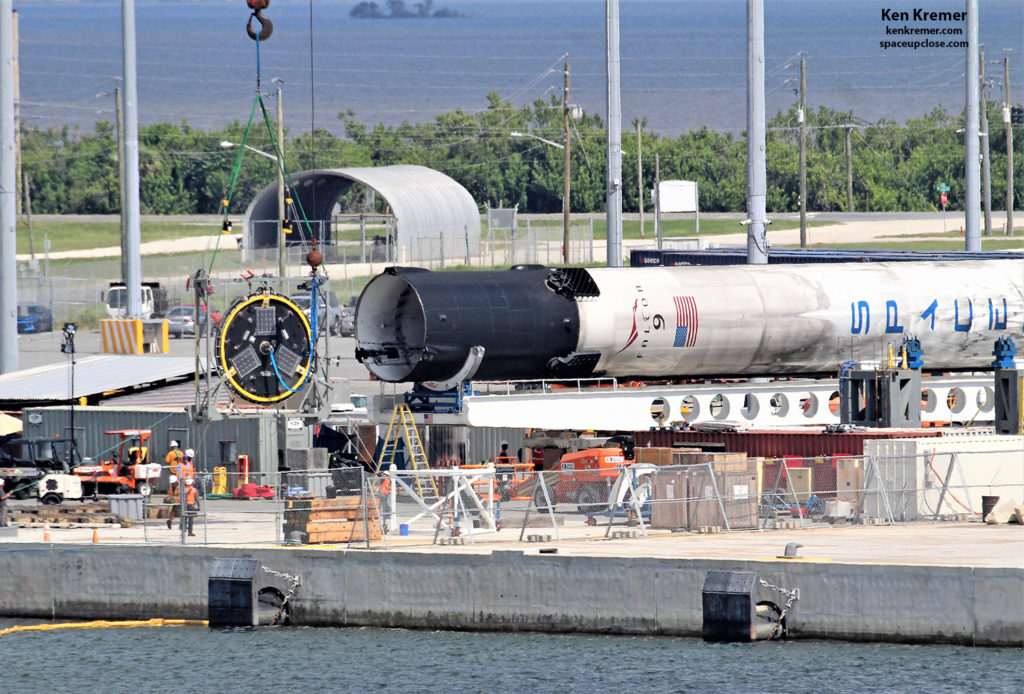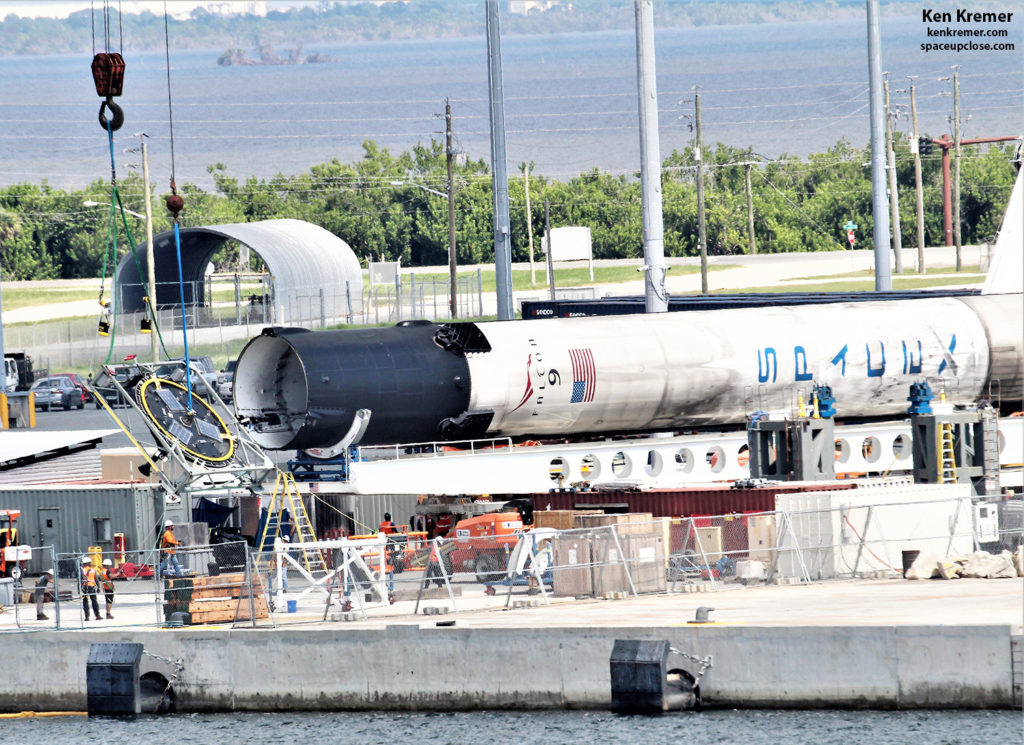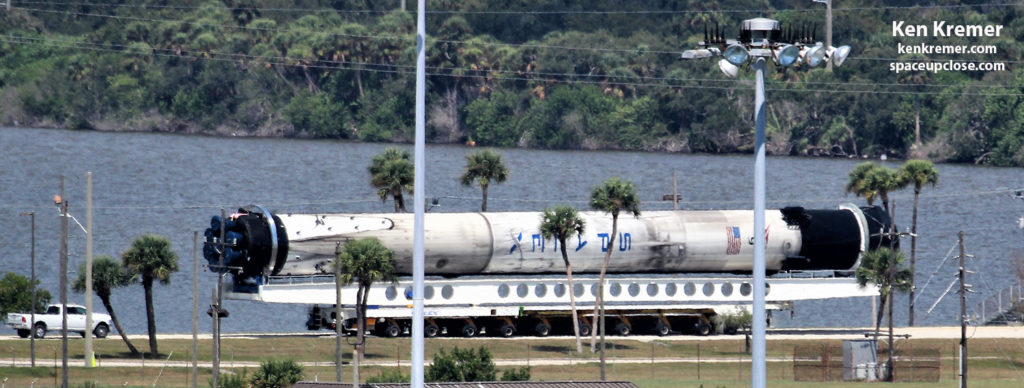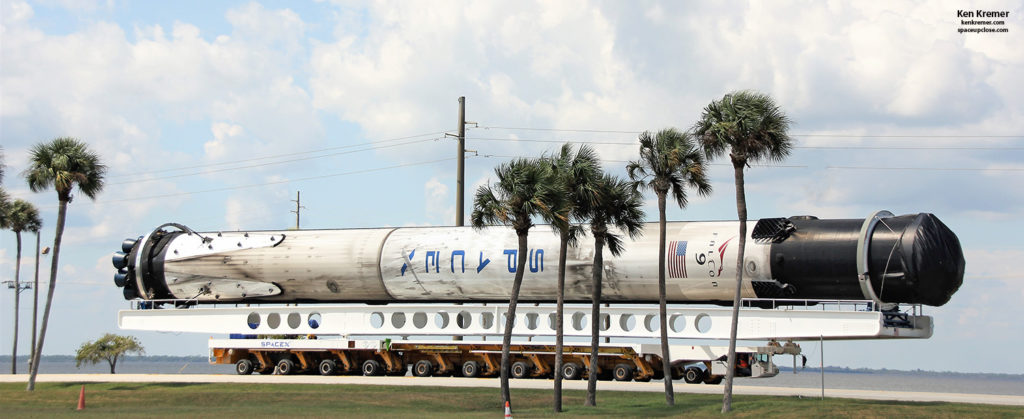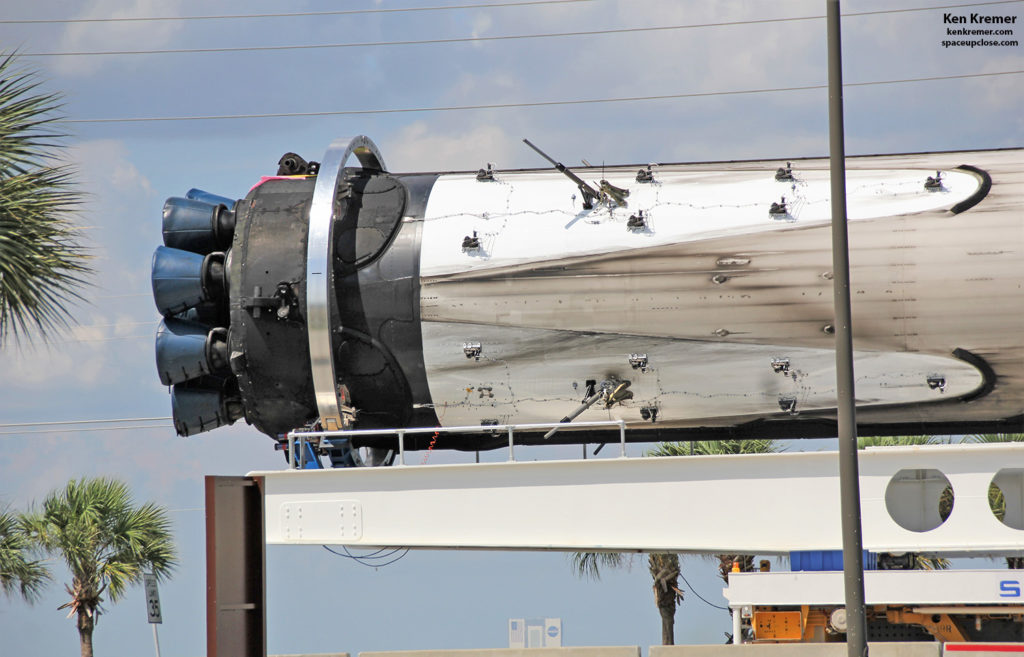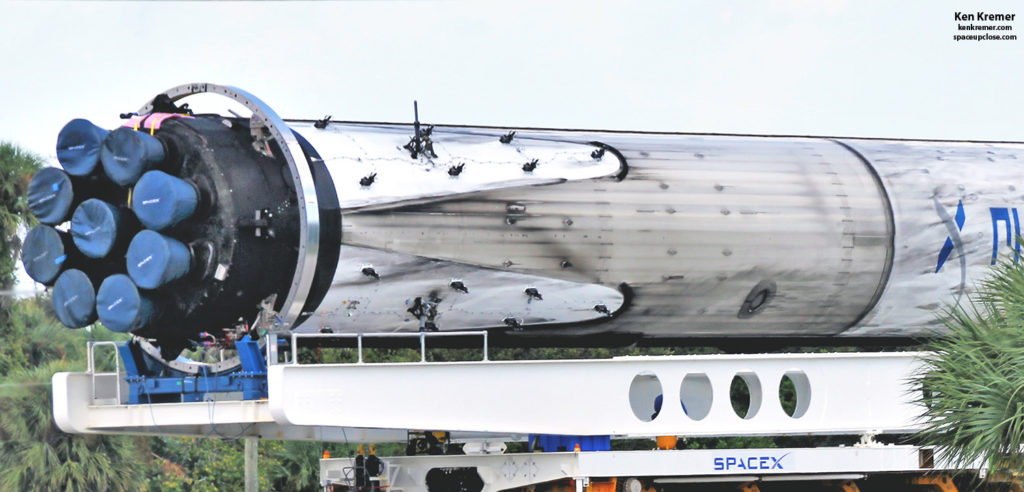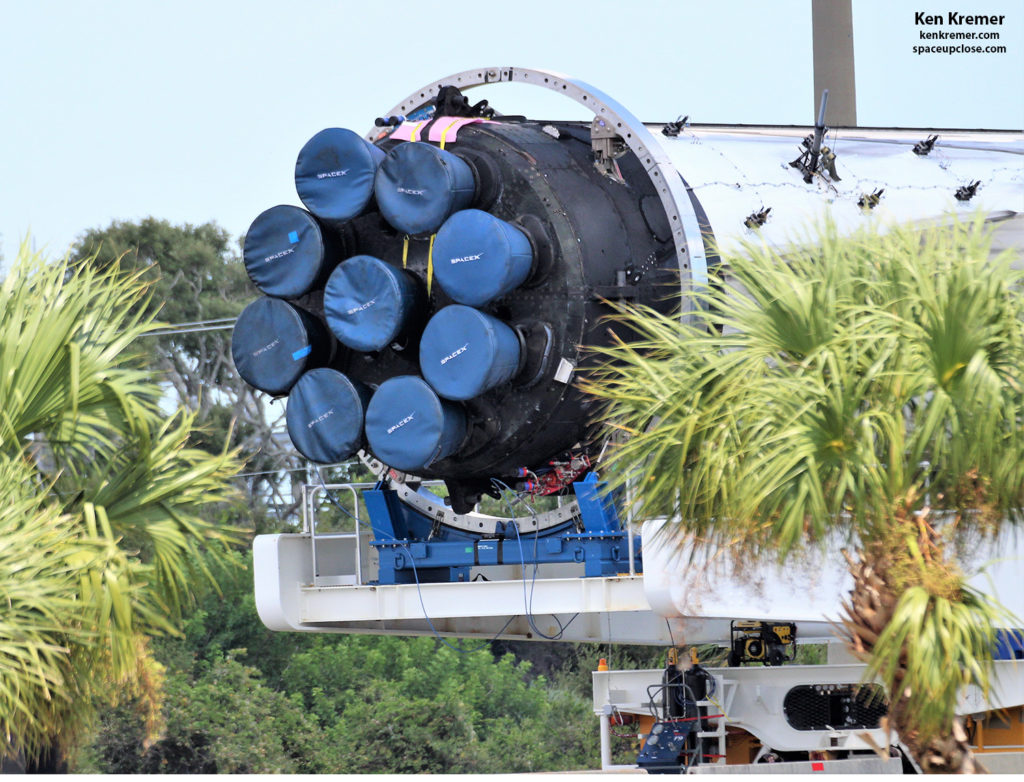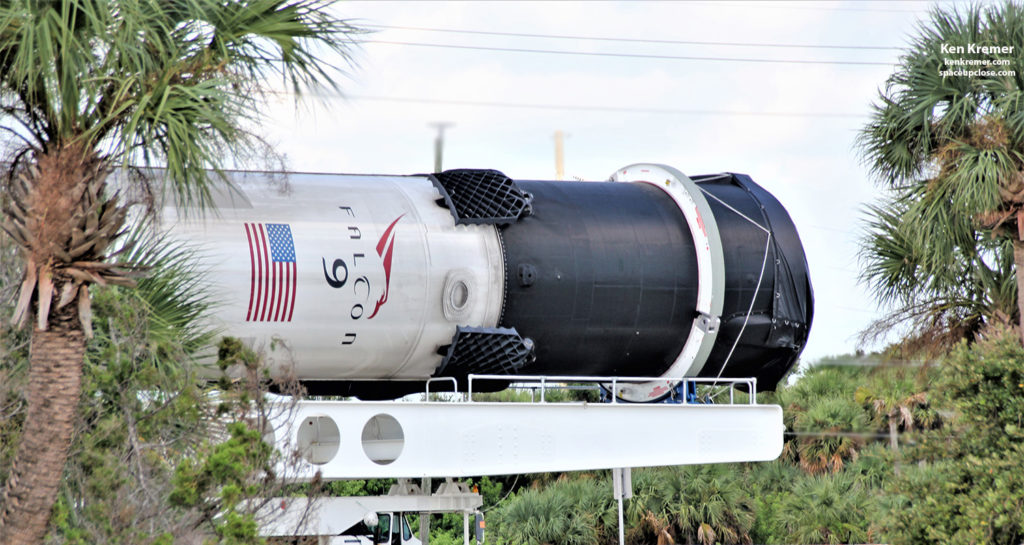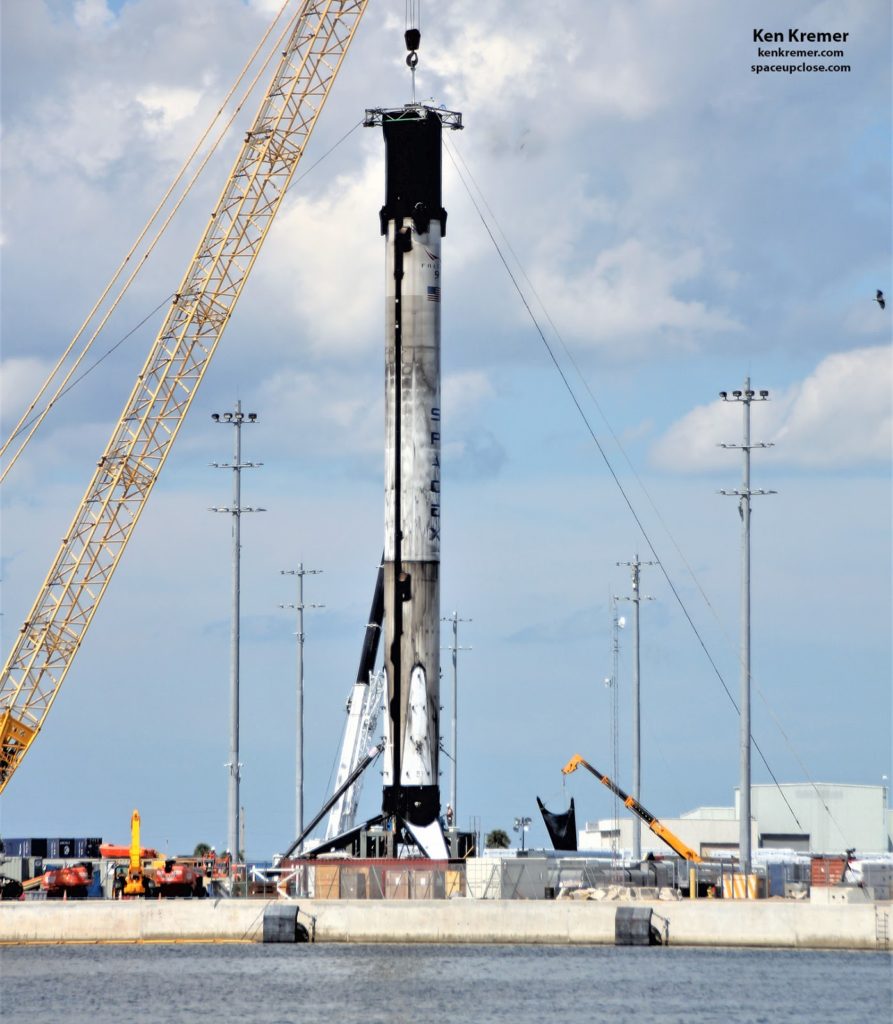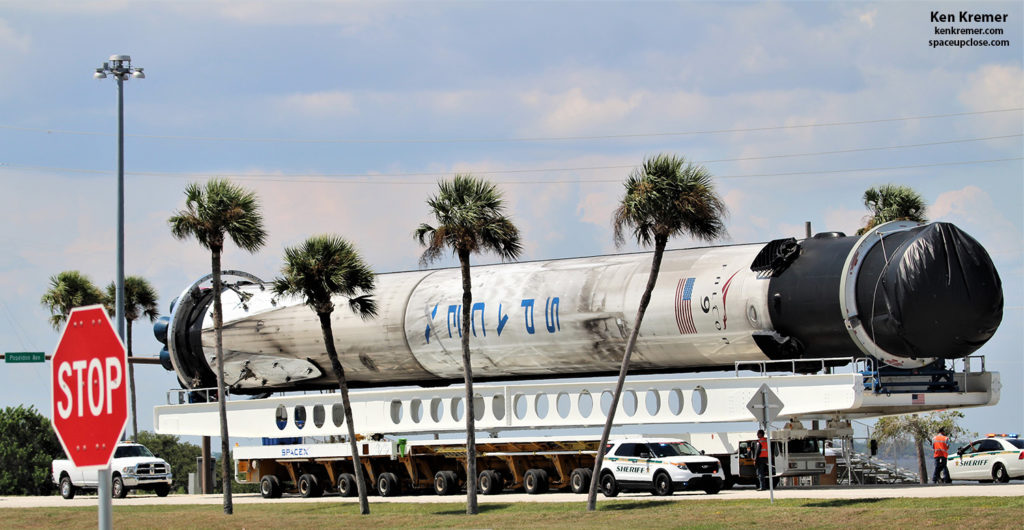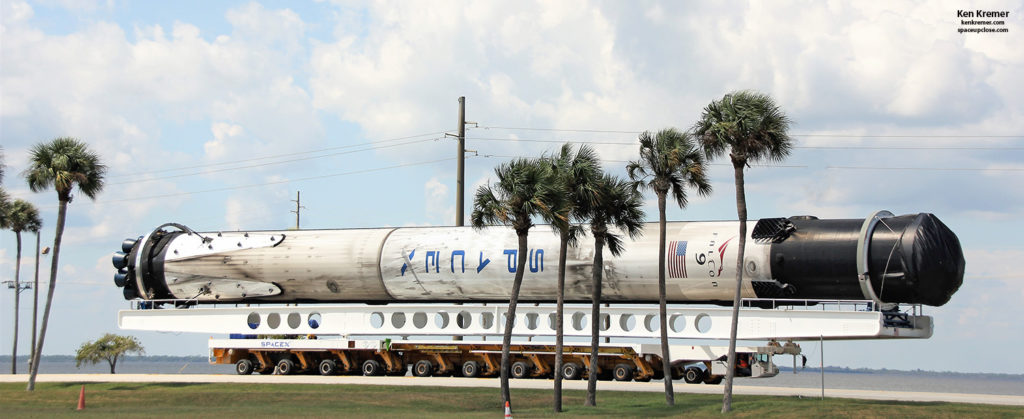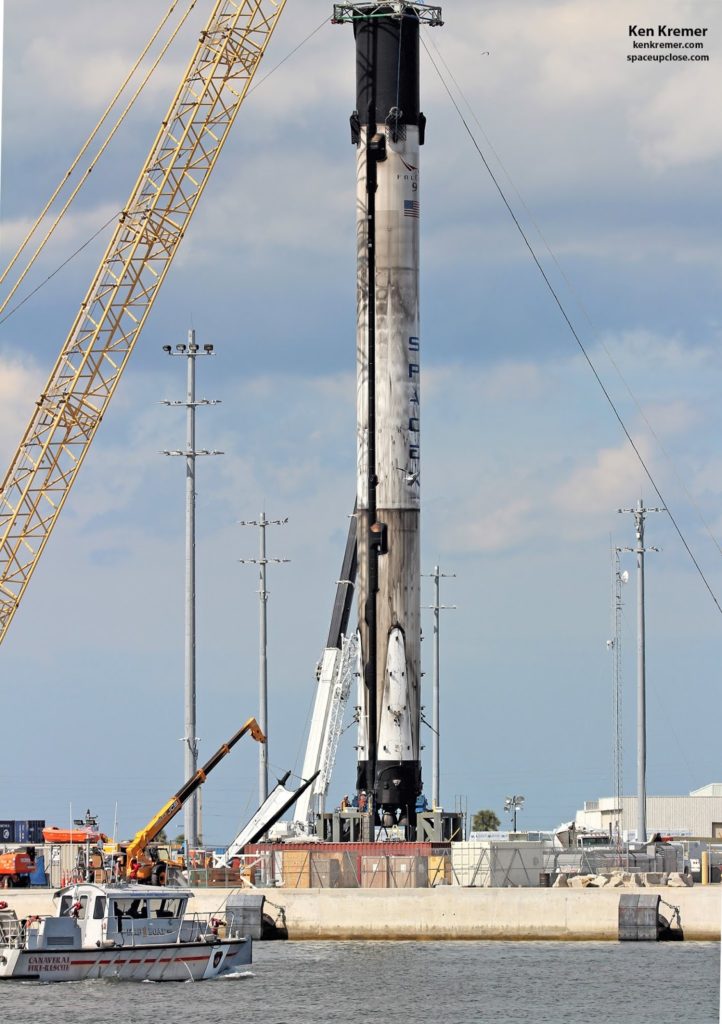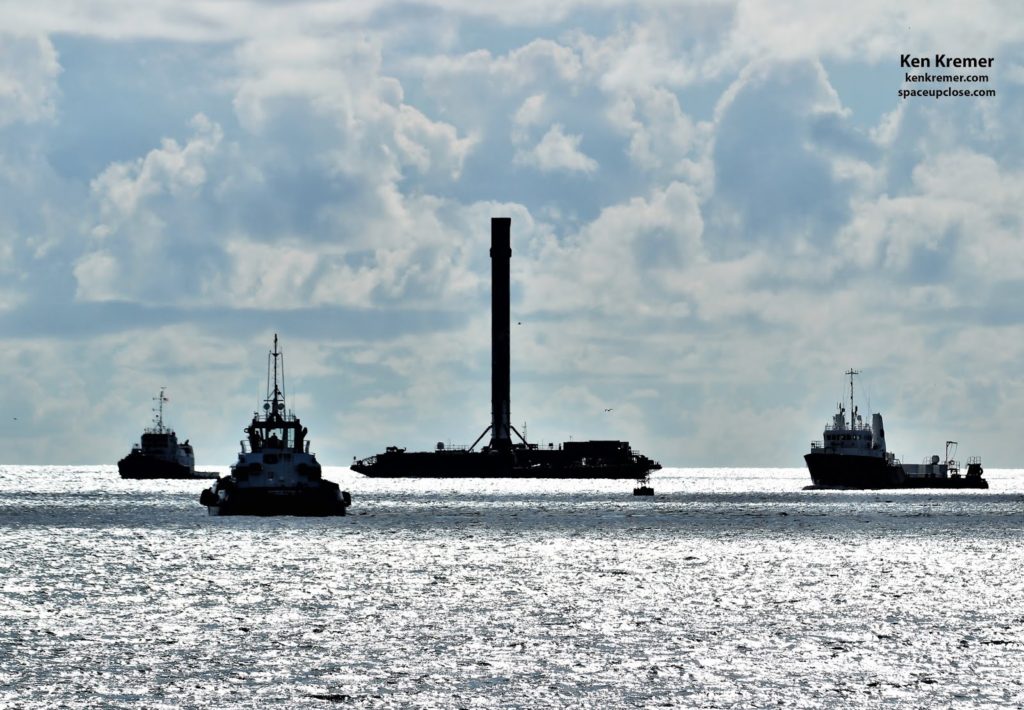— SpaceUpClose.com — 17 September 2018
PORT CANAVERAL,
FL – The legless Falcon 9 first stage booster recovered from last week’s blastoff of the Telstar 18v telecommunications satellite rolled back home horizontally into Cape Canaveral
Saturday on a specially designed transport vehicle for eventual recycling to a
future SpaceX launch for a new paying customer.
The 15-story tall booster was moved from
the Port to the Cape through the south gate Saturday afternoon, Sept. 15 after crews
spent the morning maneuvering two cranes to lower it horizontally onto a
multi-wheeled transporter and removing the hi tech hoisting device we informally
call the ‘Booster Lift/Leg Retraction Device’ or BLLRD.
Next they attached segmented mounting
rings at front and back to firmly hold the booster in place during transport
and placed a giant black colored cloth tarp cover over the now exposed inside of the
thin core skin structure to protect it from weathering.
Once all this work was completed the
booster was moved quickly into the Cape rather than remaining at the port for
another day, as has been the practice in the past.
Check out my Space UpClose gallery
of eyewitness photos detailing the BLLRD detachment by crane and the
transport of the booster on the move rolling to the Cape.
top – see my photos herein.
Saturday’s work followed on the
heels of several busy days of work wherein the crane team experimented with
retracting one of the landing legs, followed by re-lowering and ultimately
dissection/detachment of all four legs, utilizing the BLLRD – from Sept 12 to 15 after it sailed into Port Canaveral post Sept 10 launch and sea based landing.
Landing leg retraction flush against the booster core is the preferred
and necessary method for dealing with the legs if SpaceX is to succeed in their
quest for the touted 24 hour booster turnaround and relaunch with another new
payload.
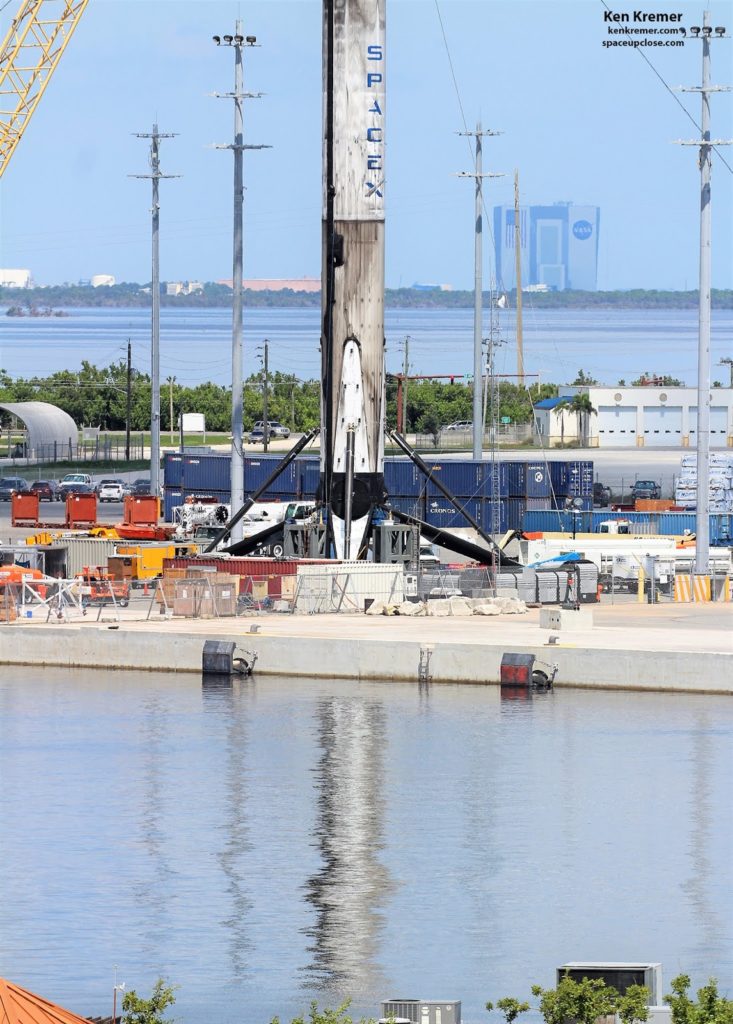 |
|
Credit:
Ken Kremer/kenkremer.com/spaceupclose.com |
Ultimately, SpaceX engineers in
concert with the crane crews apparently determined that leg removal rather than
leg retraction up against the 15-story tall core remains the best course of
action, at least for now while they work out the kinks – with respect to the upgraded
Block 5 model first stage boosters that propulsively soft land on a vessel at
sea after launching and carrying their payload to orbit.
The retraction work using the BLLRD started
rapidly, barely three days after a SpaceX Falcon 9 rocket blasted off early
Monday, Sept. 10 and successfully delivered the powerful Telesat 18v telecommunications
to orbit, and then subsequently landed safely upright on an ocean going
platform in the Atlantic Ocean.
Watch my launch video here:
Caption: Launch of SpaceX new and upgraded Falcon 9 rocket carrying Telstar 18v
telecomsat to geostationary orbit at 12:45 a.m. EDT, September 10, 2018 from Space Launch Complex 40 at Cape Canaveral Air Force Station in
Florida – as seen in this remote camera video taken at the pad. Credit: Ken
Kremer/kenkremer.com/spaceupclose.com
first stage booster sailed into Port Canaveral Wednesday September 12 – beating
out the then approaching deadly menace of Hurricane Florence.
The sooty booster was towed into
Port Canaveral atop the “Of
Course I Still Love You” (or
OCISLY) drone ship platform upon which it landed Monday
and that was prepositioned some 400 miles (640 km) off shore in the Atlantic
Ocean.
Check out our articles and photos.
SpaceX CEO and billionaire founder Elon Musk as a key improvement milestone
toward the goal of achieving far faster turnaround of ‘Flight-Proven’ first
stages for the significantly improved Block 5 version Falcon 9 vs. the older
and now retired Block 4 first stages.
In fact Musk said he aims for his
SpaceX team to launch, land and relaunch the same booster within a 24 hour
period.
To date one of the recovered Block 5
boosters has been relaunched since they debuted earlier this year.
The target date of the next SpaceX
Falcon remains TBD, likely sometime in November.
There is something of a pause as
SpaceX engineers work to ready KSC Launch Complex 39A for the resumption of
human crewed flights.
A visible sign of progress was the
installation of the crew Access Arm in August. Read our story and photos.
Watch for Ken’s continuing onsite coverage of NASA, SpaceX, ULA,
Boeing, Lockheed Martin, Orbital ATK and more space and mission reports direct
from the Kennedy Space Center, Cape Canaveral Air Force Station, Florida and
Wallops Flight Facility, Virginia.
Stay tuned here for Ken’s continuing Earth and Planetary science and human
spaceflight news: www.kenkremer.com
–www.spaceupclose.com – twitter @ken_kremer – email: ken at kenkremer.com
Dr. Kremer is a research scientist and journalist based in the KSC area.
Ken’s photos are for sale and he is available for lectures and outreach events


